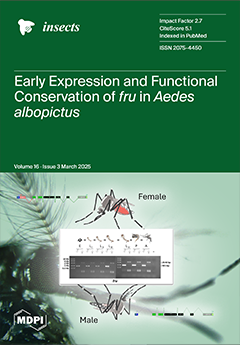Jewel beetles of the genus
Sternocera are widely distributed across tropical regions, including Thailand and Lao PDR, where the green-legged
S. aequisignata Saunders, 1866, and red-legged
S. ruficornis Saunders, 1866, are commonly found. These jewel beetles have significant economic importance, as they are
[...] Read more.
Jewel beetles of the genus
Sternocera are widely distributed across tropical regions, including Thailand and Lao PDR, where the green-legged
S. aequisignata Saunders, 1866, and red-legged
S. ruficornis Saunders, 1866, are commonly found. These jewel beetles have significant economic importance, as they are edible, and their iridescent wings are used to create jewelry, leading to high market demand and intensive harvesting. Additionally, their habitats are being rapidly destroyed, resulting in population decline. However, genetic information on these species remains limited. This study aims to investigate the genetic diversity of
S. aequisignata and
S. ruficornis from various localities in Thailand and Lao PDR using mitochondrial cytochrome c oxidase subunit 1 (
CO1) and 16S ribosomal DNA (16S rDNA) sequences. High genetic diversity was observed, with 45 and 62
CO1 haplotypes and 35 and 28 16S rDNA haplotypes identified in
S. aequisignata and
S. ruficornis populations, respectively. Haplotype network and phylogenetic analyses clearly distinguish
S. aequisignata from
S. ruficornis. Based on
CO1 sequences,
S. aequisignata was divided into three distinct haplogroups (GG1–GG3). Haplogroup GG1 was the most widespread, occurring in both Thailand and Lao PDR, while haplogroups GG2 and GG3 were restricted to some localities in northern, western, and northeastern Thailand, as well as Lao PDR. These findings suggest the presence of cryptic diversity within
S. aequisignata, with at least three genetically distinct groups. Further comprehensive studies on the biology, ecology, and genetic diversity of these jewel beetles across their distribution range are essential to better understand their evolutionary dynamics.
Full article






